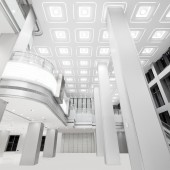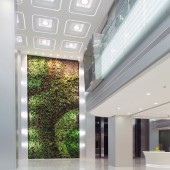Super D Technology Center Commercial Office by Hpa Architects Engineers and Development Consultants |
Home > Winners > #67488 |
 |
|
||||
| DESIGN DETAILS | |||||
| DESIGN NAME: Super D Technology Center PRIMARY FUNCTION: Commercial Office INSPIRATION: The client wanted a state of the art smart tech building but also from the planning perspective, to incorporate the future working and living habits of scientists. Super D has the vision to create a smart working space for the future. It began with the user, a future technological innovator, one that requires a smart building with an efficient design, flexible and interactive social spaces that not only serve as an office, but as a community hub that will develop new technologies of the future. UNIQUE PROPERTIES / PROJECT DESCRIPTION: Super D is a 17-storey 100 meters building. It is LEED Gold certified and awarded China’s Green Building Label, with Grade A office provisions such as universal grid, raised floor, vibration dampener. Sustainable active and passive design strategies are used. Active such as technology plugin like solar panels and smart system to conserve resources; passive design like introducing stack effect and inserting sky garden to enhance natural ventilation and lower building latent temperature. OPERATION / FLOW / INTERACTION: On the ground floor, there is a triple volume void with a generous lobby space, allowing flexible partitions that can easily assemble or dissemble for temporary exhibitions, conference or other seminar at the ground floor. To facilitate the management of control, a pre-fabricated smart system was employed to allow lighting, mounting and mobility to the panels. Besides, a universal grid was used throughout the whole building, where raised floor, wall or ceiling mount outlet was used to allow maximum layout flexibility in public and private area. The total typical floor area is 1,360 sq m. With the vertical core located on the north side, the entire south side interior has been left open to maximize the office spaces for end users. This is major layout innovation when compared with the traditional ambient offices where the central core breaks up the floor space in into different sections and creates unusable, wasted spaces. Offices on the 12/F – 17/F have a 7.5m ceiling height which enhances the spatial volume for users’ needs. Offices located in the West Wing 14/F – 17/F are provided with outdoor sky garden for multi-purpose leisure spaces in garden settings to provide the highest quality standard for an office environment. PROJECT DURATION AND LOCATION: The project was completed on 1st May 2015. The building became officially in use in 2016. The project is located in Nanshan District, Shenzhen. FITS BEST INTO CATEGORY: Architecture, Building and Structure Design |
PRODUCTION / REALIZATION TECHNOLOGY: 3 key materials used for the exterior of the building included green landscape, curved steel structures and low energy glass. A green escape not only draws people to the garden area but to reduce solar intake and enhance air quality. The curved steel structures around the rooftop garden make the building outstanding from the ambient crowd. The modern and international architectural style expresses the spirit of the high-tech age with a material palette of glass and aluminium. 3 key materials used in the interior included imported anodised aluminium panel, cove ceiling lighting and LED laminated tempered glass. The aluminium panels, with a blur blast finish, allowed maximum light diffusive reflection around corners to “hide” the columns and render walls invisible. The cove ceiling design is an iconic part of the interior and can self-calibrate into an energy efficient operation. Finally, a continuous band of LED lights changes its colour with the building maintenance system. When the building is producing energy to offset consumption or vice versa, it acts as a continuous fluid reminder to the user and guest to the building the purpose and result of sustainability. SPECIFICATIONS / TECHNICAL PROPERTIES: 45,500 mm x 35,300 mm x 100,000 mm TAGS: Commercial, Office, Building, Technology, Sustainable, Green Building RESEARCH ABSTRACT: The project is designed & constructed based on the LEED Certificate requirements; every aspect has been calculated and considered, such as the population density, the social connection, pollution and waste from construction and the materials used in the project. Firstly, the transportation system parking is designed for low carbon emitting & energy saving cars. Next, a rainwater tank is in place for water volume & quality control, a rainwater irrigation system providing 90% of the total water required for the roof garden & sky garden. There is reduced water wastage since rainwater is used for irrigation systems. Carrying on, the Urban Heat Island Effect has been decreased by the sky garden which takes up 50% of the total roof areas and minimizes reflective paved surfaces. On the exterior, the façade system’s external louvers are provided to minimize any potential gain and merge it with the building design. A minimum 75% of the façade area receives natural lighting which achieves the government requirement for lighting and vision. Combined with our premium cooling medium system, this building reaches the minimum energy consumption standard. Altogether, the building is a grade 5A facility – top standard commercial building facility. CHALLENGE: The hardest part of the design activity was trying to reduce resource consumption in order to achieve the LEED Gold Label and China's Green Building Label, while also abiding by the client's brief of having a high technology center fit for the future of scientists. In order to overcome these difficulties, we had to be innovative not only in our energy usage systems, but also in the actual building design, such as having a combination of sustainable elements and vertical greenery reducing the heat absorbing surfaces. ADDED DATE: 2018-03-23 12:55:35 TEAM MEMBERS (1) : IMAGE CREDITS: Hpa Architects Engineers and Development Consultants, 2017. |
||||
| Visit the following page to learn more: http://bit.ly/2I0yWLr | |||||
| AWARD DETAILS | |
 |
Super D Technology Center Commercial Office by Hpa Architects Engineers and Development Consultants is Winner in Architecture, Building and Structure Design Category, 2017 - 2018.· Read the interview with designer Hpa Architects Engineers and Development Consultants for design Super D Technology Center here.· Press Members: Login or Register to request an exclusive interview with Hpa Architects Engineers and Development Consultants. · Click here to register inorder to view the profile and other works by Hpa Architects Engineers and Development Consultants. |
| SOCIAL |
| + Add to Likes / Favorites | Send to My Email | Comment | Testimonials | View Press-Release | Press Kit |
Did you like Hpa Architects Engineers and Development Consultants' Architecture Design?
You will most likely enjoy other award winning architecture design as well.
Click here to view more Award Winning Architecture Design.








